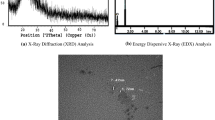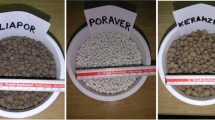Abstract
An important property which affects the heat transfer process in buildings and to minimize the usage of artificial energy in buildings is thermal conductivity. The transfer of heat through walls and roofs determines the amount of artificial energy required in the buildings. The conventional methods used to determine the thermal conductivity of buildings are transient and steady state methods. The objective of this paper is to measure the thermal conductivity of concrete specimens replacing nanosilica and GGBS by weight of ordinary Portland cement. Nanosilica was replaced by weight of cement in different proportions ranging from 1% to 5%. Addition of nanosilica and GGBS in concrete improves the compressive strength and split tensile strength of concrete by around 10%. Improvement in strength properties is mainly due to densification of concrete microstructure by filling pores in concrete specimens. In addition to the strength characteristics, nanosilica incorporated concrete specimens showed better thermal resistance as compared with conventional concrete mix. Lower heat transfer rate is due to the better particle packing nature of nanoparticles in concrete. Nanosilica acts as better heat retarding agent in concrete and thus it minimizes the use of artificial energy in the buildings. It is concluded that utilization of nanosilica reduces the heat transfer rate in to the buildings and the optimum amount of nanosilica was found to be 3% by weight of cement.
Similar content being viewed by others
References
Palla R, Karade SR, Mishra G, Sharma U, Singh LP (2017) High strength sustainable concrete using silica nanoparticles. Constr Build Mater 138:285–295
Kahn, J. (2006), Nanotechnology. Natl Geogr, 98–119
White SR, Sottos NR, Moore J, Geubelle P, Kessler M, Brown E et al (2000) Autonomic healing of polymer composites. Nature 409:794–797
Praveenkumar TR, Vijayalakshmi MM (2015) Effect of Nano particles on the properties of concrete. Int J Chemtech 8(7):50–55
Murthi P, Poongodi K, Awoyera PO, Gobinath R, Saravanan R (2020) Enhancing the strength properties of high-performance concrete using ternary blended cement: OPC. Nano-silica, bagasse ash. Silicon 12:1949–1956. https://doi.org/10.1007/s12633-019-00324-0
Ronzhya YR, Praveenkumar TR (2015) Durability study of self compacting concrete using hybrid glass Fibres. Int J ChemTech Res 8(2):836–844
Kirthika K, Praveen Kumar TR (2015) Experimental investigation Onflexural behaviour of glass beams with stainless steel. Int J ChemTech Res 8(7):434–443
Praveenkumar TR, Vijayalakshmi MM (2019) Microstructural properties of nano-rice husk ash concrete. Nanotechnol Environ Eng 4:9. https://doi.org/10.1007/s41204-019-0056-4
Meddah MS, Praveenkumar TR, Vijayalakshmi MM, Manigandan S, Arunachalam R (2020) Mechanical and microstructural characterization of rice husk ash and Al2O3 nanoparticles modified cement concrete. Constr Build Mater 255:119358
Praveenkumar TR, Vijayalakshmi M, Manigandan M (2019) Thermal conductivity of concrete reinforced using TiO2 nanoparticles and rice husk ash. Int J Ambient Ener. https://doi.org/10.1080/01430750.2019.1691649
Kumar R, Mathur R, Mishra AK (2011) Opportunities & challenges for use of nanotechnology in cement-based materials , NBMCW
Drexler KE (1986) Engine of creation. Anchor Book Edition, N.Y
Deb B-W (2008) Nanotechnology: ethics and society. Taylor and Francis Group, N.Y
Sanchez F, Sobolev K (2010) Nanotechnology in concrete - A review. Constr Build Mat 24(11):2060–2071
Sobolev K, Ferrada-Gutiérrez M (2005) How nanotechnology can change the concrete world: part 2. Am Ceramic Soc Bull 11:16–19
Mohseni E, Naseri F, Amjadi R, Khotbehsara MM, Ranjbar MM (2016) Microstructure and durability properties of cement mortars containing nano-TiO2 and rice husk ash. Constr Build Mater 114:656–664
Najigivi A, Khaloo A, Irajizad A, Rashid SA (2013) Investigating the effects of using different types of SiO2 nanoparticles on the mechanical properties of binary blended concrete, composites. Part B 54:52–58
Lin DF, Lin KL, Chang WC, Luo HL, Cai MQ (2008) Improvements of nano-SiO2 on sludge/fly ash mortar. Waste Manag 28(6):1081–1087
Patel K (2012) The use of nanoclay as a constructional material. Int. J. Eng. Res. Appl. 2(2):1382–1386
Morsy MS, Alsayed SH, Aqel M (2011) Hybrid effect of carbon nanotube and nano clay on physico-mechanical properties of cement mortar. Constr Build Mater 25:145–149
Wang W-C (2017) Compressive strength and thermal conductivity of concrete with nanoclay under various high-temperatures. Constr Build Mater 147:305–311
Mukharjee BB, Barai SV (2014) Influence of nano-silica on the properties of recycled aggregate concrete. Constr Build Mater 55:29–37
Ying J, Zhou B (2017) Jianzhuang XiaoPore structure and chloride diffusivity of recycled aggregate concrete with nano-SiO2 and nano-TiO2. Constr Build Mater 150:49–55
Wang WJ, Wu J, Wang Z, Wu GZ, Yue AY (2016) Chloride diffusion coefficient of recycled aggregate concrete under compressive loading. Mater Struct 49(11):4729–4736
Niewiadomskia P, Stefaniuk D, Hołaa J (2017) Microstructural analysis of self-compacting concrete modified with the addition of nanoparticles. Procedia Eng 172:776–783
Patel R, Patel C (2016) Pratik Patel a review paper on measure thermal conductivity. JETIR 3(2):51–53
Kim K, Jeon S, Kim J, Yang S (2003) An experimental study on thermal conductivity of concrete. Cem Concr Res 33(3):363–371
Khan MI (2002) Factors affecting the thermal properties of concrete and applicability of its prediction models. Build Environ 37(6):607–614
Campbell-Allen D, Thorne CP (1963) The thermal conductivity of concrete. Mag Concr Res 15(43):39–48
Harmathy TZ (1970) Thermal properties of concrete at elevated temperature. J Mater 5(1):47–74
Harmathy TZ, Allen LW (1973) Thermal properties of selected masonry unit concretes. ACI J Proc 70(2):132–142
WeipingZhang HM, Gu X, Xi Y, Xing Y (2015) Mesoscale model for thermal conductivity of concrete. Constr Build Mat 98:8–16
Asadi I, Shafigh P, Hassan ZFBA (2018) Norhayati Binti Mahyuddin, thermal conductivity of concrete - a review. J Build Eng 20:81–93
Oner A, Akyuz S (2007) An experimental study on optimum usage of GGBS for the compressive strength of concrete. Cem Concr Compos 29(6):505–514
BS EN 12390–3: 2009, Testing hardened concrete—part 3 compressive strength of tests specimens, British Standards Institution, London
IS 5816 1999(R2004), Method of Test Splitting Tensile Strength of Concrete, Bureau of Indian Standards, India
Acknowledgements
The authors would like to thank Sathyabama Institute of Science and technology for their extensive support in conducting the study. The authors also would like to support Dr. Manigandan S, Research associate, Kaoshiung Medical University, Taiwan for his technical ideas to carry out this study.
Author information
Authors and Affiliations
Corresponding author
Additional information
Publisher’s Note
Springer Nature remains neutral with regard to jurisdictional claims in published maps and institutional affiliations.
Rights and permissions
About this article
Cite this article
Reddy, L.S.I., Vijayalakshmi, M.M. & Praveenkumar, T.R. Thermal Conductivity and Strength Properties of Nanosilica and GGBS Incorporated Concrete Specimens. Silicon 14, 145–151 (2022). https://doi.org/10.1007/s12633-020-00813-7
Received:
Accepted:
Published:
Issue Date:
DOI: https://doi.org/10.1007/s12633-020-00813-7




